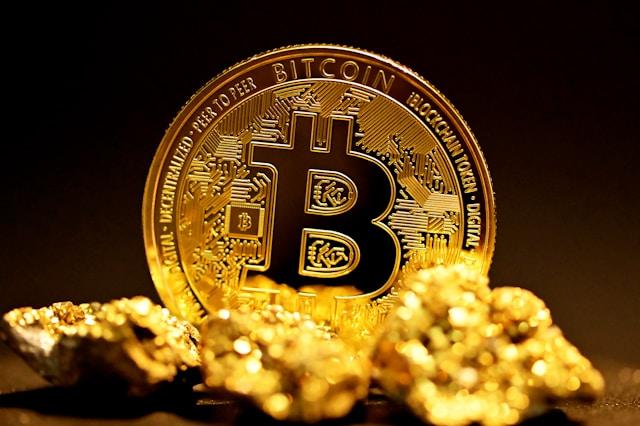5 Ways Precious Metals Blend With Blockchain Investments
Gold’s reputation as a safe, reliable investment goes back centuries. There's a reason civilizations hoarded it, governments tied their currencies to it, and investors today still flock to it during economic uncertainty.
Why is that? Well, for one, gold holds its value over time and acts as a hedge against inflation. But it also doesn’t get influenced by the whims of government policy, which, in today’s highly uncertain times, is a major plus.
However, when it comes to high-growth investments with quick returns, nothing beats Bitcoin. While gold has been one of the most stable investments for centuries, Bitcoin has skyrocketed in value in recent years. It’s also purely digital, meaning transactions are as fast and straightforward as they can be.
But why choose between the two? Both gold and blockchain offer unique benefits that, when paired, can help balance your portfolio and improve your long-term financial security.
The Stability of Precious Metals
First, let’s revisit why precious metals like gold and silver have always been viewed as “safe” investments: their scarcity and intrinsic value give them staying power in turbulent markets. Gold, for example, has been a store of wealth for millennia, while silver also has industrial demand that further boosts its appeal.
Whether you’re purchasing through ETFs or physical bullion from trusted sources like Pimbex, a notable bullion dealer, these metals remain independent of any central authority or economic policy, making them ideal during inflationary periods or financial crises.
This is where they have an advantage compared to more volatile assets - metals simply don’t crumble when stock markets crash or when fiat currencies lose value. If anything, their price tends to rise during those times.
Hedging Against Volatility
The cryptocurrency world can be exciting, but it can also be a roller coaster. Bitcoin and Ethereum can gain 20% in a day just as easily as they can lose it. Even with the potential for significant returns, these kinds of swings can be nerve-wracking for any investor.
That’s why traditional assets like gold can be a wise choice. By adding gold or silver to your blockchain-heavy portfolio, you’re effectively hedging against the volatility of digital currencies.
Gold and silver hold steady, regardless of what happens in the crypto market. So if Bitcoin crashes, your gold investment softens the blow. In essence, precious metals balance out the inherent risk tied to crypto investments. And this doesn’t mean sacrificing growth potential for security - your crypto assets can still thrive during bullish phases, while your metals ensure you won’t lose everything when the market turns sour.
Long-Term Value Retention
While blockchain technology and cryptocurrencies are relatively new, the potential for long-term growth is undeniable. But it’s important to acknowledge that this growth might not be linear, and many cryptocurrencies could fade over time. That’s why precious metals remain a vital piece of the puzzle.
Gold, in particular, has retained its value over millennia. It may not generate explosive returns, but it does provide you with a level of long-term security that digital assets can’t (yet) guarantee. If you’re holding onto crypto as a long-term bet, you’ll want something to back up your high-risk positions. And precious metals offer precisely that - consistent value retention. You don’t have to trade one for the other; instead, let each complement the other’s strengths.
Diversification Strategies for a Balanced Portfolio
Everyone talks about diversification, but the real art lies in how you diversify. Having a blend of both physical assets (like gold or silver) and digital assets (like Bitcoin or Ethereum) not only diversifies your portfolio but also spreads your risk across different asset classes.
Precious metals and cryptocurrencies move based on completely different factors. Cryptos are impacted by developments in blockchain technology, investor sentiment, and regulatory changes, while precious metals are influenced by global economics, inflation, and geopolitical risks. When one market is down, the other may be up. Diversifying in this way ensures that your portfolio isn’t overly dependent on one market’s fortunes (or misfortunes).
Combining Growth and Security
So, what does a portfolio with both precious metals and cryptocurrencies look like? For one, it’s a blend of growth and security. Cryptocurrencies offer the potential for massive gains, while precious metals provide a solid foundation. This way, you’re not betting your entire financial future on a single market, and you can take advantage of opportunities without exposing yourself to excessive risk.
It's all about flexibility. You can benefit from crypto’s upside without losing sleep over the downturns because your gold and silver positions act as a protective buffer. This is especially valuable during uncertain economic times when both stock markets and cryptos could be highly volatile.
How Precious Metals and Blockchain Are Intersecting
Interestingly, there’s even a growing intersection between the two. Blockchain technology is being used to tokenize precious metals, creating digital representations of physical gold and silver. This allows investors to trade and hold fractional shares of these assets, merging the benefits of precious metals with the liquidity and ease of digital trading. Platforms like Paxos and Tether Gold are already leading this innovation.
So, if you’re keen on blockchain but don’t want to stray too far from the safety of gold, tokenized metals may be a smart middle ground.
In the end, it's about being prepared for the future. Holding both precious metals and blockchain assets allows you to create a balanced and diversified portfolio that marries the potential for explosive growth with long-term security. In other words, it's a recipe for a secure financial future.

